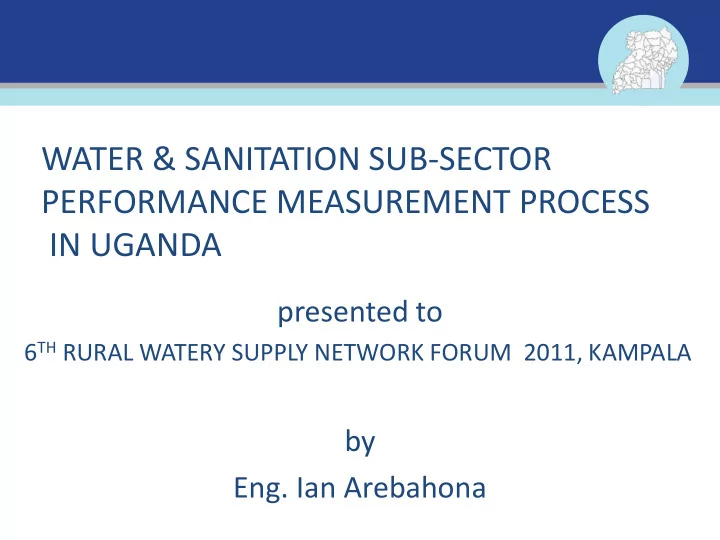

WATER & SANITATION SUB-SECTOR PERFORMANCE MEASUREMENT PROCESS IN UGANDA presented to 6 TH RURAL WATERY SUPPLY NETWORK FORUM 2011, KAMPALA by Eng. Ian Arebahona
Presentation Outline 1. Background 2. Performance measurement framework 3. Stakeholders & roles in data/information collection and update 4. Data capture tool in Rural Water Supply 5. Main outputs in RWS measurement 6. Way forward
Background to Water & Sanitation Performance Measurement 1. Policy, Legal & Institutional Environment: a) Constitution 1995 - Govt. policy objectives; framework for decentralization; sustainable development; right & responsibilities to clean & healthy environment b) Decentralization Policy 1994, The Local Government, Cap 243 – transfer of functions, powers, roles & responsibilities to local govts to ensure good governance and participatory democracy c) Divestiture & Privatization Policy 1993, The Public Enterprises Reform & Divestiture Act – govt. divests itself of service functions and restructures utilities to increase private sector participation to improve quality, coverage & economic efficiency d) Water Action Plan 1995, Water Policy 1999, The Water Act, Cap 152 – rational mgt & use of Uganda water resources; provision of safe & adequate water supply for all social & economic needs ; recognize both social & economic value of water; user responsibility for O&M for sustainability; gender; management at the lowest appropriate level
Background to Water & Sanitation Performance Measurement (2) 2. Water and Sanitation Sub-sector Reforms (since1997) • Objectives: – Compliance with overarching government reform requirements – Embrace global trends (Aid effectiveness, partnership principles, JBSF, etc) – Sector effectiveness, efficiency, equity, reduce government burden • Key outcomes: – SWAP; strengthening & use of govt. systems by stakeholders – Rural WS; decentralised planning/ implementation (112 districts) – Urban WS; Separate asset ownership from mgt, Commercialised service delivery, Regulation framework – WRM; Integrated water resources management, Deconcentration (WMZ, CBO) • Implication: Need for agreed planning, monitoring & reporting framework by various stakeholders/implementers 4
Water & Sanitation Sub-sector Performance Measurement Framework (2003) 1. Golden Indicators for performance measurement (11 No): [in response to Objective Planning & Reporting requirement] – Access to safe water (rural & urban) – Functionality of improved water sources (rural, urban, wfp) – Per capita investment cost (rural, urban) – Access to improved sanitation (rural, urban, primary schools) – Water quality (wrm) – Quantity of water (wfp) – Equity (rural) – Access to handwashing facilities (household, primary schools) – Water facilities management (rural, urban wfp) – Gender in WUC & WB (rural, urban & wfp) – Compliance with permit conditions (wrm) 2. Reporting timeframe : Quarterly (Progress) & Annually 5 (SPR)
Data & information capture/update: Stakeholders & roles 1. Water Users / Local Leadership – report on functionality & management status of their water supply facilities 2. Local Governments, Water Operators – main data / information providers for self & national reporting and accountability 3. Projects Managers (GOU, DP, NGO) - periodic progress & accountability reports. Coordination needed. 4. Local Govt. Support Units (TSUs, UOs, WSDFs, WMZs) - Support LGs/Operators ensure compliance, processing data & submission to centre, information dissemination 5. Sub-sectors – handle and disseminate specific information, manage operational databases 6. MIS Unit – Compile & disseminate sector reports, coordinate MWE with collaborating agencies 6
Data Capture Tool in RWS 7
Data Capture Tool in RWS (2) 8
Main outputs in RWS 1. Created RWS Database 100,000 water sources data entered Generate 28 standard reports (national / district) Query tool to prepare customized reports Hosted on ministry website (authority required for access/use) 2. Performance Progress Reports – compile with other info: Management reports (1/4, 1/12) to MFPED, OPM Sector reports to Parliament (MPS), MFPED (BFP), JSR (SPR) 3. Produced Uganda Water Supply Atlas (2001, 2010) Combined water sources information with population & administrative boundaries (UBOS) to produce atlas Water Atlas on ministry website (public document) 9 www.mwe.go.ug/publications
District source location map: Soroti District 10
National access by district 11
National functionality by district 12
National Pie Charts 13
National Maps: Boreholes shows the spatial distribution of the different type of water sources in the country. For the actual number of water sources please refer to the district specific tables. These maps indicate clearly which technology dominates in different areas of the country. Graduated circle maps (smaller scale)give the approximate number of water sources in each district. For example, the bigger the circle the greater the number of water sources. The key also be used to obtain a quick estimate of the number of sources occurring for each circle size. 14
Way forward • Continuous & timely up-date of the water sources & sanitation data • Strengthen/enforce information flow ( reporting routines ) to centre and feedback to users (quarterly/annually). • Improve linkage and collaboration with other National MIS Agencies (UBOS, MFPED, MLG, MOH, OPM, MOES, DPs, UWASNET. ..). 15
END Thank you for your attention 16
Recommend
More recommend